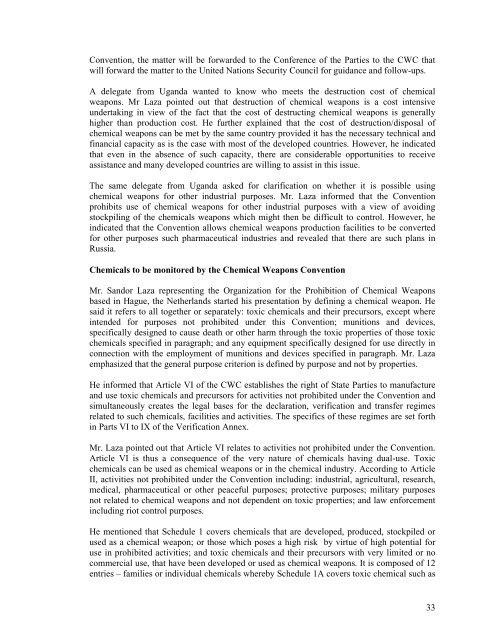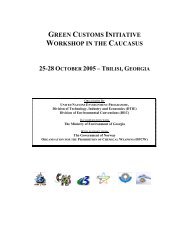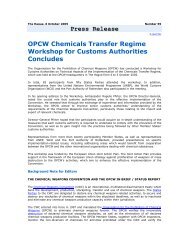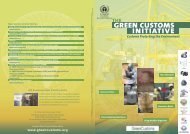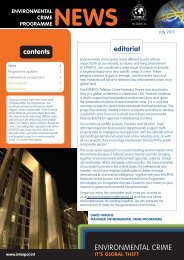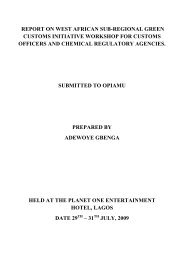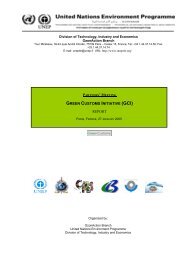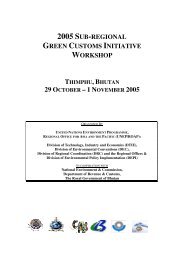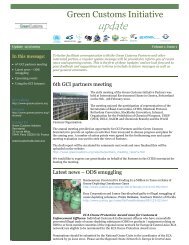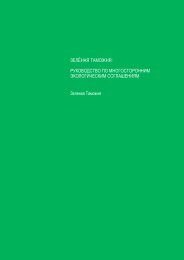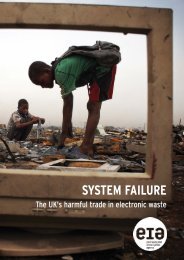Arusha - Green Customs Initiative
Arusha - Green Customs Initiative
Arusha - Green Customs Initiative
Create successful ePaper yourself
Turn your PDF publications into a flip-book with our unique Google optimized e-Paper software.
Convention, the matter will be forwarded to the Conference of the Parties to the CWC that<br />
will forward the matter to the United Nations Security Council for guidance and follow-ups.<br />
A delegate from Uganda wanted to know who meets the destruction cost of chemical<br />
weapons. Mr Laza pointed out that destruction of chemical weapons is a cost intensive<br />
undertaking in view of the fact that the cost of destructing chemical weapons is generally<br />
higher than production cost. He further explained that the cost of destruction/disposal of<br />
chemical weapons can be met by the same country provided it has the necessary technical and<br />
financial capacity as is the case with most of the developed countries. However, he indicated<br />
that even in the absence of such capacity, there are considerable opportunities to receive<br />
assistance and many developed countries are willing to assist in this issue.<br />
The same delegate from Uganda asked for clarification on whether it is possible using<br />
chemical weapons for other industrial purposes. Mr. Laza informed that the Convention<br />
prohibits use of chemical weapons for other industrial purposes with a view of avoiding<br />
stockpiling of the chemicals weapons which might then be difficult to control. However, he<br />
indicated that the Convention allows chemical weapons production facilities to be converted<br />
for other purposes such pharmaceutical industries and revealed that there are such plans in<br />
Russia.<br />
Chemicals to be monitored by the Chemical Weapons Convention<br />
Mr. Sandor Laza representing the Organization for the Prohibition of Chemical Weapons<br />
based in Hague, the Netherlands started his presentation by defining a chemical weapon. He<br />
said it refers to all together or separately: toxic chemicals and their precursors, except where<br />
intended for purposes not prohibited under this Convention; munitions and devices,<br />
specifically designed to cause death or other harm through the toxic properties of those toxic<br />
chemicals specified in paragraph; and any equipment specifically designed for use directly in<br />
connection with the employment of munitions and devices specified in paragraph. Mr. Laza<br />
emphasized that the general purpose criterion is defined by purpose and not by properties.<br />
He informed that Article VI of the CWC establishes the right of State Parties to manufacture<br />
and use toxic chemicals and precursors for activities not prohibited under the Convention and<br />
simultaneously creates the legal bases for the declaration, verification and transfer regimes<br />
related to such chemicals, facilities and activities. The specifics of these regimes are set forth<br />
in Parts VI to IX of the Verification Annex.<br />
Mr. Laza pointed out that Article VI relates to activities not prohibited under the Convention.<br />
Article VI is thus a consequence of the very nature of chemicals having dual-use. Toxic<br />
chemicals can be used as chemical weapons or in the chemical industry. According to Article<br />
II, activities not prohibited under the Convention including: industrial, agricultural, research,<br />
medical, pharmaceutical or other peaceful purposes; protective purposes; military purposes<br />
not related to chemical weapons and not dependent on toxic properties; and law enforcement<br />
including riot control purposes.<br />
He mentioned that Schedule 1 covers chemicals that are developed, produced, stockpiled or<br />
used as a chemical weapon; or those which poses a high risk by virtue of high potential for<br />
use in prohibited activities; and toxic chemicals and their precursors with very limited or no<br />
commercial use, that have been developed or used as chemical weapons. It is composed of 12<br />
entries – families or individual chemicals whereby Schedule 1A covers toxic chemical such as<br />
33


